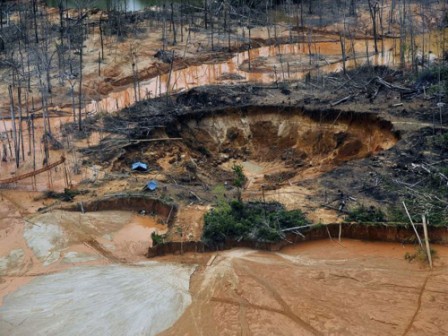Amazon slowly eaten away by gold rush's illegal mines
Lima
Seen from above, the Amazon resembles a huge billiards table -- a field of intense green pockmarked by brown stains.
These are the sites of illegal mines, and they reveal the scope of a gold rush that threatens the lungs of the planet.
"The loss of our natural resources is incalculable," says Antonio Fernandez Jeri, Peru's high commissioner on illegal mining.
"Each lost hectare represents unique flora and fauna species," he told AFP.
In his country, a new, unprecedented operation has shut down 55 illegal mining sites since mid-July. Those sites are in the Madre de Dios region, where approximately 150,000 acres (60,000 hectares) of forest have already been lost due to illegal mining.
Peru leads South America in gold production and ranks fifth globally, but authorities there say 20 percent of its exported gold comes from these clandestine mines.
But this mining, which first began in the 1980s, extends beyond Peru. In every Amazon country, the largest forest in the world is being slowly eaten away by an explosion of tiny, unreported mines.
According to a study published in January in the British journal Environmental Research Letters, approximately 415,000 acres of tropical forest were cleared for potential gold mining sites in South America between 2001 and 2013.
"Although gold mining deforestation is usually less extensive than deforestation for agriculture, it happens in some of the most biodiverse tropical regions," said lead author Nora Alvarez-Berrios of the University of Puerto Rico-Rio Piedras.
She says up to 300 different species of trees can be found in a single hectare of Peru's Madre de Dios region. Her study refers to the region as "one of the most biologically rich areas on Earth."
"Like drug trafficking, illegal mining activity is widespread," Fernandez Jeri said. "That's why we need to find strategic allies and do something. We have a technical commission with Ecuador as well as with Bolivia and Colombia. We still need to sort out the question with Brazil."
In Brazil, illegal mining activity is taking place in nine of 26 states. President Dilma Rousseff recently set a goal of achieving a rate of zero deforestation over the next 15 years.
- Mercury pollution -
In Colombia, flying over the Puinawai reserve, near the Brazilian border, reveals the scope of the damage, as trees are cut and brush torn out to get to the precious metal.
But there is other, less immediately obvious damage as well. To extract one gram of gold, miners have to use two to three grams of another metal: mercury, which then pollutes surrounding soils and streams and threatens those living nearby with "proven cases of infertility and skin and stomach damage," according to Fernandez Jeri.
This deforestation and pollution has destroyed some indigenous lands in Peru, forcing inhabitants to leave their seclusion and search out new food sources, resulting in conflicts with other tribes.
In Bolivia, mining sites are increasingly operated by cooperatives with their work papers in order but no environmental permits, according to a report from the Peruvian Society of Environmental Rights.
"Mining activity, whether legal or not, impacts the environment," said Alvaro Pardo, director of the Colombia Punto Medio Center for Mining Studies.
"The problem is that when illegal miners leave an area, they just go, leaving behind huge losses that all of Colombia then needs to pay for," he said.
Mining is nevertheless a critical part of the South American economy, as the region remains one of the world's main sources for raw materials.
"Small-scale mining activity, as the World Bank calls it, or artisanal mining, has to continue to exist. It can't stop," Pardo conceded.
"But it has to be an economic activity that is developed sustainably, without affecting the environment."
In Peru, permit applications for 60,000 mining sites are already filed, but, according to official estimates, there are still 100,000 unreported sites in the country, destroying a little bit more of the forest ecosystem each day.
Related Posts

